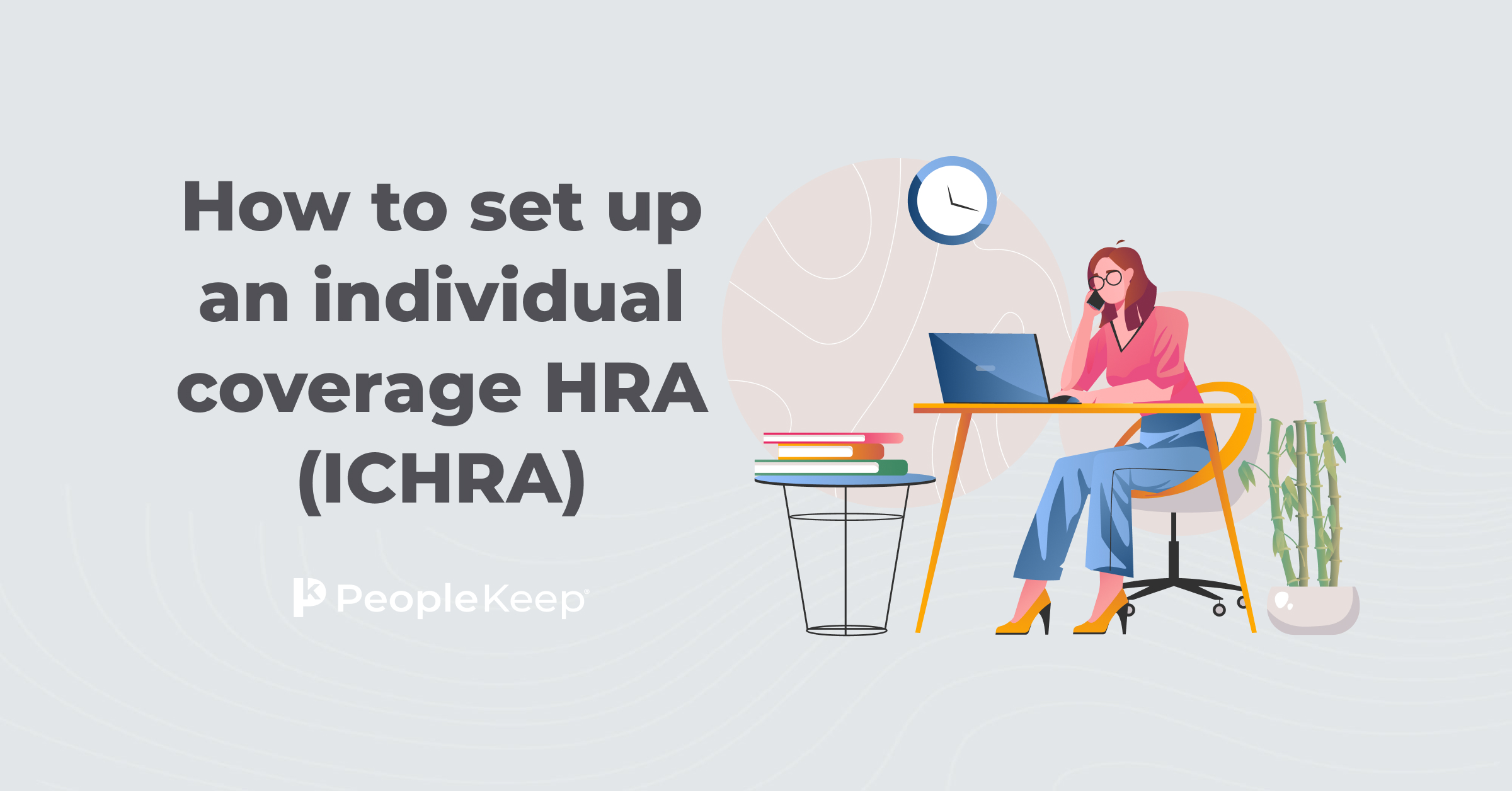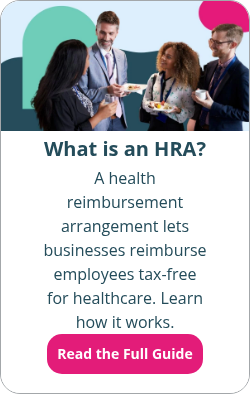HRA compliance FAQs
By Holly Bengfort on March 26, 2024 at 10:16 AM
Health reimbursement arrangements (HRAs) are an increasingly popular option for employers looking to provide affordable healthcare benefits to their employees. They are a great way for employers to offer health coverage without the limitations or cost of traditional group health insurance.
Since HRAs are a relatively new benefit and are therefore unfamiliar to many, those considering this type of health plan may have questions regarding regulations and compliance. Employers may have questions about what's allowed under an HRA and what actions could potentially lead to penalties or non-compliance.
In this article, we'll cover the most frequently asked questions businesses have about HRA compliance and some helpful ways you can keep your employee benefit in compliance with the Affordable Care Act, ERISA, and IRS regulations.
Takeaways from this blog post:
- HIPAA privacy rules govern the disclosure of PHI in HRAs, requiring employers to have written privacy procedures in place and designated privacy officers.
- Employees receiving reimbursements through an HRA must submit proper documentation for eligible expenses. This documentation needs to remain on file for seven years to comply with IRS requirements.
- Partnering with a software administration platform like PeopleKeep can help ensure HRA compliance and avoid potential pitfalls.
What is an HRA?
An HRA is an IRS-approved, employer-funded health benefit. With an HRA, employers can reimburse employees for their eligible medical expenses. Employers set aside a defined amount of money for the HRA each year, and employees can use those funds to pay for a wide range of qualified medical expenses, such as deductibles, copays, and prescription medications. Depending on the type of HRA, this can also include health insurance premiums. Each type of HRA has its own rules and regulations regarding eligibility, annual contribution limits, and reimbursement requirements.
There are several different types of HRAs, including:
- The qualified small employer HRA (QSEHRA): The QSEHRA is for small businesses with fewer than 50 full-time equivalent employees (FTEs) that don’t offer a group plan. It provides W-2 employees tax-free reimbursements for insurance premiums and sometimes out-of-pocket costs as long as they have minimum essential coverage (MEC), regardless of whether that’s through an individual health insurance plan or a group plan from a parent or spouse. There are maximum contribution limits with a QSHERA.
- The individual coverage HRA (ICHRA): The ICHRA works for employers of all sizes. It offers more flexibility than a QSEHRA. The ICHRA has no limit on employer contributions. Employers can also separate their workforce into 11 classes of employees. This allows them to offer different allowance amounts to different workers, such as seasonal employees and temporary employees. Eligible employees must have their own individual insurance coverage with MEC to participate in the benefit.
- The group coverage HRA (GCHRA): The GCHRA, also known as an integrated HRA, works alongside a traditional group health plan. It helps cover out-of-pocket expenses that aren’t fully paid for by the group plan. Unlike the QSEHRA and ICHRA, employers can’t use a GCHRA to reimburse employees for insurance premiums.
- The excepted benefit HRA (EBRHA): Like the GCHRA, employers can use an EBHRA to supplement an existing group health insurance plan. With an EBHRA, employers can reimburse their employees for monthly premiums paid towards certain excepted benefits and other eligible out-of-pocket medical care expenses.
What should HRA plan documents include?
The first step in offering an HRA is to establish a formal plan with the creation of legal plan documents. These documents define the structure and parameters of the plan and outline eligibility, allowances, and claim procedures.
A complete plan document should include the following:
- Named fiduciaries and plan administrators and their responsibilities
- Eligibility requirements for the HRA
- Effective dates of participation
- Description of benefits provided and excluded
- How the HRA is funded and how it makes payments
- Claims procedures
- HIPAA privacy officers and rules relating to the use of protected health information (PHI)
- Information on federal mandates and the procedure for amending the plan
- The procedure for plan termination
In addition to the plan documents, you need to have a summary plan description (SPD) that's available to participating employees. The SPD is a simplified version of the complex language included in the main plan documents.
The purpose of this document is to provide employees participating in the HRA with an accurate and easy-to-understand description of the plan structure, rules, and procedures. The SPD should be comprehensive enough to inform participants of their benefits, rights, and obligations under the plan.
Where do I get HRA plan documents?
An employer can create plan documents on their own, but it can be difficult to ensure the requirements are accurately represented. Alternatively, a business can work with a lawyer to draft the documents, but this option can be expensive and usually doesn't include compliance support.
Employers can also work with a third-party benefits administrator (TPA), who may be able to help draft plan documents, but this means giving up control of your health benefits to someone else.
As a fourth option, an employer can work with an HRA benefits advisor or administrator, like PeopleKeep, to provide the documents and assist the business in implementing the formal plan. This is the best option for most companies as it removes the burden of creating complex legal documents and provides the employer with a supportive resource regarding compliance issues.
What are the HRA employee privacy rules?
HIPAA privacy rules dictate the circumstances under which an employer or administrator can disclose an employee's PHI, regardless of the organization’s size. The rules state employers offering an HRA must adopt certain written PHI privacy procedures.
The written privacy procedures must include:
- Safeguards for the administration of PHI
- Physical, electronic, and technical security of such information
- A process for employees to follow when filing and dealing with complaints
- Designated company HIPAA privacy officers who will directly handle employees' PHI
Employers must take any measures necessary to see that they don’t use PHI for making employment or benefits decisions. An employer who is administering their own HRA can follow these rules, but like other aspects of compliance, they can be difficult to adhere to without the help of an HRA benefits advisor or software administrator.
What are the HRA substantiation requirements?
The IRS requires employees who receive reimbursements through an HRA to submit proper documentation for their eligible expenses, known as substantiation. This supporting documentation must remain on file for at least seven years.
Employees can provide this documentation directly to the company's designated privacy officers or through a third party.
Examples of documentation used to substantiate healthcare expenses are:
- An itemized receipt
- An explanation of benefits
- A detailed billing history
Depending on the item or service the employee requests a reimbursement for, they may also need to submit a doctor’s note to prove medical necessity.
Failure to substantiate an expense or keep the required documentation on file could result in a negative result in the case of an IRS audit.
Can an HRA satisfy the employer mandate?
According to the ACA's employer mandate, employers with 50 or more FTEs must offer a health plan that meets minimum essential coverage (MEC) to at least 95% of FTEs and their dependents. The coverage must also meet the ACA's minimum value and affordability requirements.
Historically, HRAs have been primarily utilized by small businesses exempt from the employer mandate. But that has since changed with the creation of the ICHRA.
Unlike other HRAs, the ICHRA, when implemented correctly, can satisfy the employer mandate for large employers. Employees participating in the ICHRA must have individual health insurance coverage with MEC. This takes care of the MEC and minimum value requirements.
In order for an employer to fully meet the employer mandate with an ICHRA, they must ensure their contributions are affordable. An affordable ICHRA contribution ensures the cost of health insurance for an employee isn't more than 9.96% of their monthly household income, using the lowest-cost silver plan on their local exchange as the standard.
Employers can ensure compliance with the employer mandate and avoid penalties by offering an ICHRA with affordable contributions for employees, as long as they also follow other aspects of HRA compliance.
Conclusion
Knowing the best ways to keep your HRA compliant will save you from many headaches and pitfalls. While it's possible for a business to administer an HRA on its own, self-administration comes with inherent difficulties and risks.
Partnering with an HRA software administration platform like PeopleKeep puts employers in a more risk-free position by eliminating administrative and compliance difficulties.
PeopleKeep doesn’t provide legal advice. This article is for informational purposes only. To ensure compliance with the law, you should seek professional assistance from tax experts.
This article was originally published on January 10, 2020. It was last updated on March 26, 2024.
Check out more resources
See these related articles

HRAs and W-2 annual reporting
Learn about HRA W-2 annual reporting requirements. Understand what employers need to include on employees' W-2 forms for HRA compliance.

HRA administration: What features to expect from your provider
Discover the key features of HRA administration. Learn what to expect from your provider to ensure smooth setup, compliance, and employee support.

How to set up an individual coverage HRA (ICHRA)
Ready to offer ICHRA? Follow this guide to learn how to set up an Individual Coverage HRA, from plan design to compliance and employee communication.



